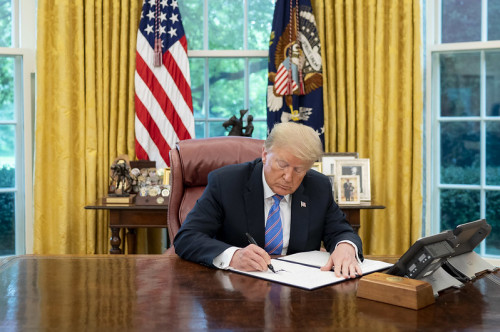
Adam Brandon is a strategic advisor to The Independent Center. He has a Center bias.
Getting Congress to accomplish anything seems like an almost impossible task. By nearly every measure, the 118th Congress from 2023 to 2024 was one of the least effective in history. The reasons for this dysfunction are many: political polarization, hyper-partisanship, razor-thin majorities – you name it.
For the President of the United States, one solution is a frequently manipulated tool: executive orders.
Discussions about the President’s ability to push through his agenda using executive orders have surged. Outgoing President Biden issued a series of orders to halt offshore drilling for fossil fuels, expedite the development of data centers for artificial intelligence, and enhance cybersecurity against foreign and domestic hackers.
Meanwhile, President Donald Trump and his team of advisors arrived on inauguration day, prepared with a range of executive orders. Some of which had teeth even before Monday, January 20th. TikTok, for example, began restoring its service to its users on Sunday.
Executive orders might circumnavigate partisan entrenchment, but this isn’t a viable fix to Congressional ineptitude.
President Barack Obama said in his 2014 State of the Union address that if Congress won’t help him get things done, he’d do it on his own. This led many Republicans to label Obama as “emperor” for his inability to move through the legislature.
Fast forward to President Trump’s first term in 2017, and many of the Republicans who expressed disdain towards Obama actively cheered executive actions taken by the new administration.
What do you think it’s called when a party criticizes executive overreach when the opposition is in power, but cheers for it when their side is in control?
The sheer number of executive orders issued by the President is steadily increasing and reflects a gradual shift of legislative authority away from Congress and toward the Presidency. In Barack Obama’s first 100 days in office, he issued 19 executive orders. Donald Trump issued 33. As for Joe Biden? He issued 42.
That’s not how our government is supposed to work.
Remember, the founders of our representative Democracy were incredibly skeptical of a legislative body that could pass laws at the drop of a hat. In other words, Congress was never designed to move quickly and efficiently. Instead, public debate in the House and Senate were intended to be the means of reaching an agreeable compromise, with various factions coming together in a bipartisan manner.
It’s understandable that many are frustrated with Congress today. After all, saying that Congress wasn’t designed to move quickly and efficiently doesn’t mean it should do nothing at all. There are legitimate issues facing our country. From entitlement programs like Social Security and Medicare running bankrupt to a broken immigration system, these are significant challenges that require both parties to come together to advance long-term solutions.
However, when solutions are pushed through via executive order, we further disincentivize open debate and appropriate legislative channels.
Our country requires Congress to operate more effectively. In a poll conducted by the Independent Center in July among registered voters, 60 percent of respondents expressed disapproval of Congress's performance.
Instead of ignoring this discontent and circumventing the process, I hope the incoming administration will boldly challenge Congress to legislate and operate effectively.
Executive orders may provide a quick fix and generate immediate headlines, but they contribute to deeper political polarization and hinder Congressional functionality. Ultimately, executive orders reinforce the concept of an imperial presidency. Both parties would agree that this poses a danger to our system of government.
